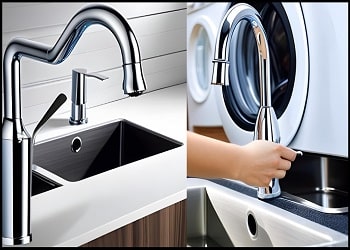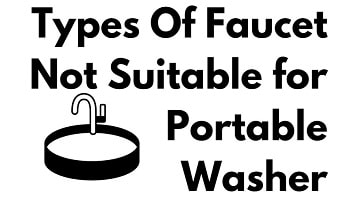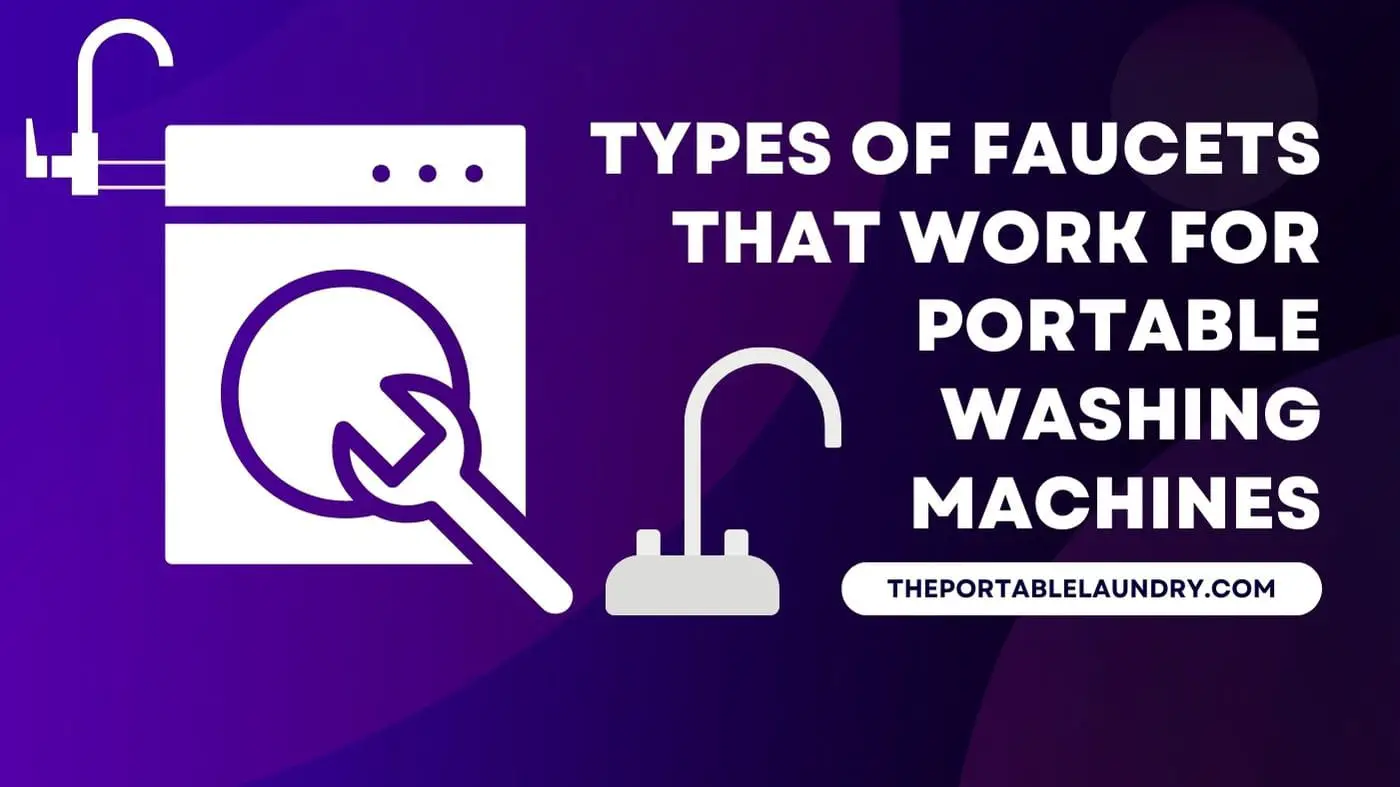A portable washing machine is a compact laundry appliance tailored to individuals seeking efficient washing in small spaces or while traveling.
Designed for space-saving functionality, these devices eliminate the need for a traditional laundry room setup.
However, their operation is dependent on a dependable water supply and drainage system, thus the need for the right faucet becomes extremely important.
Faucets are pivotal in facilitating water input for washing and aiding drainage after the wash cycle.
To guarantee a smooth operational experience, it’s crucial to take into account factors like faucet type, alignment with your portable washer, and the comprehensive installation procedure.
In this article, we will dive into the details of faucet types that align most effectively with portable washers.
Table of Contents
Types of Faucets That Work for Portable Washing Machines

There are several alternatives to consider when equipping your portable washing machine with the proper faucet connection.
Each style of faucet is crucial in ensuring a consistent water supply and efficient drainage for your portable washer.
Let’s look into a number of faucets that work with portable washing machines in more detail:
Faucet Divider with Aerator
The faucet divider with an aerator is a wise option for anyone looking for flexibility and efficiency.
This specific faucet design has an integrated aerator that efficiently controls water flow and encourages water conservation.
You can simultaneously join your portable washing machine and other types of equipment thanks to the unique divider layout.
Also, with this design, switching between tasks is simple and doesn’t require constant reattachment.
Single-Handle Kitchen Faucet
A classic option that works well with portable washing machines is choosing a kitchen faucet with a single handle.
Its user-centric design facilitates effortless control over water temperature and flow through the use of a single lever.
This faucet type ensures a steady water supply to your portable washer, and its unique design provides ample space for filling and emptying the machine.
The versatility of the single-handle kitchen faucet makes it a popular option for various kitchen tasks, including connecting to your portable washing machine.
Single-Handle Bathroom Faucet
The single-handle bathroom faucet is another compact option that’s suitable for portable washing machines.
It offers a streamlined design that fits well in smaller spaces.
While it might have a lower water flow rate compared to a kitchen faucet, it still provides sufficient water supply for your washing needs.
Its space-saving design makes it a great choice for apartments or areas with limited counter space.
Elkay Kitchen Faucet
The Elkay kitchen faucet is recognized for its exceptional quality and lasting durability.
If you’re in search of a resilient solution for your portable washing machine, this faucet style can be an excellent alternative.
Elkay faucets often come with features like adjustable water flow and multiple spray options, making them versatile for various tasks.
With solid construction and reliable performance, the Elkay kitchen faucet ensures a steady water supply for your portable washer.
When exploring various faucet options for portable washing machines, bear in mind aspects such as installation, upkeep, and compatibility with water pressure.
Every faucet type boasts its distinct merits, making it essential to select the one that best fits your requirements and goes well with limited space.
Types of Faucets that may not work well

While most faucet styles can effectively complement portable washing machines, a handful of types might not be as appropriate due to their specific design or functionality.
Here is a list of faucet types that may not be compatible with portable washing machines:
Pull-Down Faucets
Pull-down kitchen faucets often have a hose that can be extended and pulled down into the sink.
While these faucets are convenient for various tasks, the hose might interfere with the proper connection of the portable washing machine’s inlet hose.
Wall-Mounted Faucets
Wall-mounted faucets are installed on the wall above the sink rather than on the sink deck.
These faucets might not provide the necessary clearance for connecting the portable washing machine’s hose.
Additionally, the angle at which the hose needs to be connected might be awkward with a wall-mounted faucet.
Faucets with Non-Standard Connections
Some faucets might have unique or non-standard connections that don’t easily accommodate the attachment of the portable washing machine’s inlet hose.
These faucets might require additional adapters or modifications to work with the machine.
Faucets with Low Water Flow
Faucets with very low water flow rates might not provide enough water pressure for the optimal operation of a portable washing machine.
It’s important to ensure that the chosen faucet can deliver adequate water flow for the machine’s needs.
Faucets with Complex Installation
Faucets that require complex or specialized installation procedures might not be ideal for connecting to a portable washing machine.
It’s important to have a faucet that can be easily installed and uninstalled when needed.
Faucets with Short Spouts
Faucets with short spouts might not provide enough clearance for comfortably attaching the portable washing machine’s hose.
It’s important to have sufficient space to connect the hose without any kinks or bends.
Also Read: Are all washing machine hoses the same?
How to Choose the Right Faucet for Your Portable Washing Machine?
Selecting the perfect portable washing machine faucet is a pivotal step in ensuring a hassle-free laundry experience.
Various considerations influence this choice, each playing a role in ensuring smooth water supply and efficient drainage.
Here’s a comprehensive guide on how to choose the right faucet for your portable washing machine:
Consider the Type of Faucet You Want
Begin by pinpointing the faucet style that aligns most effectively with your requirements.
Consider the alternatives we previously explored, encompassing the faucet divider with an aerator, single-handle kitchen faucet, single-handle bathroom faucet, and the dependable Elkay kitchen faucet.
Each variant presents its distinctive array of attributes and benefits, thus select the one that best suits your requirement.
Consider the Size of Your Sink
The dimensions of your sink play a crucial role in determining the appropriate faucet size.
A faucet that’s too tall might result in splashing, while one that’s too short could restrict your washing machine’s access to water.
Optimal coordination between the faucet and sink size is key for efficient water supply and proper drainage.
Consider the Height of Your Portable Washer
The height of your portable washer is another critical factor.
Different machines have varying dimensions, so it’s important to choose a faucet with sufficient clearance.
Measure the distance between the faucet and the top of your washer to ensure a seamless fit.
Water Pressure Compatibility
Opt for a faucet that provides adequate water pressure to facilitate efficient washing.
Look for options with adjustable water flow settings to tailor the pressure according to your needs.
Faucet Installation Compatibility
Evaluate the installation requirements of the faucet and ensure they match your plumbing setup.
Opt for a faucet that can be installed easily without extensive modifications.
DIY-friendly installation is a plus, saving you time and potential hassle.
Aesthetics and Design
While functionality is paramount, the visual appeal of the faucet matters, especially if it’s in a visible area.
Choose a faucet with a design that complements your kitchen or laundry area’s aesthetics.
Brand Reputation and Quality
Prioritize reputable brands known for their faucet quality and longevity.
A well-crafted faucet is less likely to develop leaks or other issues over time.
Choosing a reliable brand ensures a steady water supply for your portable washing machine without unnecessary disruptions.
By factoring in these considerations i.e., faucet type, sink size, and washer height you can confidently choose a faucet that not only meets your portable washing machine’s water supply needs but also seamlessly integrates into your laundry space.
Installation Instructions
Now that you’ve chosen the perfect portable washing machine faucet for your laundry setup, it’s time to proceed with the installation process.
Ensuring a correct and secure installation is vital for smooth water supply and efficient washing. Follow these steps to set up your faucet for your portable washer:
Attach the Faucet Divider to the Main Faucet
- Begin by turning off the water supply to your existing faucet. This is usually done by closing the water valves under the sink.
- If you’re using a faucet divider with an aerator, unscrew the existing aerator from your main faucet’s spout. Keep this aerator in a safe place as you might need it later.
- Gently screw the faucet divider onto the main faucet’s spout. Make sure it’s securely attached and properly aligned. This divider allows you to have two outlets: one for your portable washing machine and the other for regular use.
Connect the Portable Washer to the Faucet Divider
- Check the connectors provided with your portable washer. They should include the necessary adapters to connect to the faucet divider.
- Attach the appropriate adapter to the end of the portable washer’s water inlet hose.
- Connect the portable washer’s hose to the outlet on the faucet divider. Ensure a snug fit, but don’t overtighten to avoid damaging the components.
- Once the connection is secure, turn on the water supply valves and test the connection for any leaks. The connections should be tightened as necessary if you notice any leakage.
With the faucet divider and portable washer properly connected, you’ve successfully set up your portable washing machine’s water supply.
Tips for Using Your Portable Washing Machine with a Faucet
With your portable washing machine faucet now properly installed, the next step involves utilizing it efficiently for the best possible outcomes.
Here are a few pointers to bear in mind when employing your portable washer in tandem with the selected faucet:
Water Temperature Control
Depending on your portable washing machine’s settings, adjust the water temperature to match your laundry requirements.
Most portable washers allow you to select between hot and cold water, providing flexibility for different types of fabrics.
Load Size and Detergent
Follow the manufacturer’s guidelines for load capacity and detergent usage.
Overloading the machine can lead to inefficient washing while using too much detergent might result in excess suds.
Water Flow Regulation
If your faucet comes with an adjustable aerator, experiment with different water flow settings.
Optimal water pressure can lead to improved cleaning performance while conserving water.
Monitoring Drainage
Ensure that the drainage hose is properly positioned and connected to your sink or drainage system.
This prevents water spills and ensures efficient drainage during and after the wash cycle.
Balancing the Load
Properly distribute your laundry inside the drum to prevent the machine from becoming unbalanced during the spin cycle.
An unbalanced load can cause excessive vibrations and potential damage to the machine.
Maintenance
Regularly clean the lint filter and any other accessible parts of your portable washing machine. This ensures its longevity and efficient operation over time.
Conclusion
Selecting the right faucet for your portable washer is a crucial step in creating a functional and efficient laundry setup.
With options like the faucet divider with aerator, single-handle kitchen faucet, single-handle bathroom faucet, and the reliable Elkay kitchen faucet, you can tailor your choice to your specific needs and preferences.
By considering factors such as faucet type, sink size, and portable washer height, you can ensure a seamless installation process.
Moreover, taking into account water pressure compatibility, faucet features, installation ease, aesthetics, and brand reputation will guide you in making the optimal choice.
You May Also Like
- Portable Washing Machine: Can It Use Regular Hookups?
- Using Portable Washing Machines Without Hoses? Read this!
- Portable Washers: How They Work & their working principles
- How to use a portable washing machine effectively?
- Hook up a portable washer to the sink in 10 easy steps
- The Ultimate Guide to troubleshoot Portable Washing Machine Issues
- The Ultimate Guide to Storing Your Portable Washing Machine

